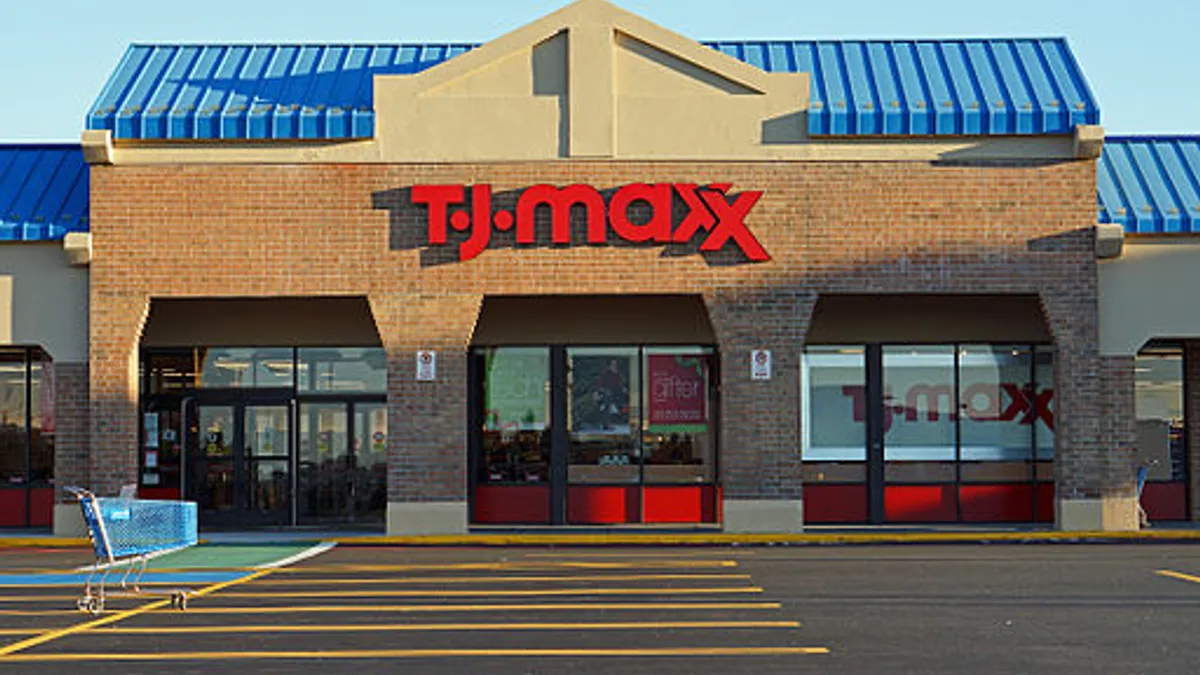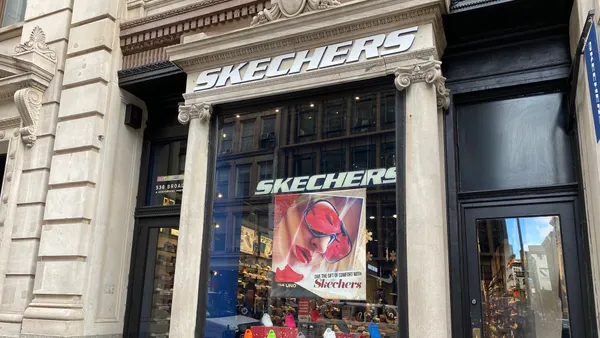Dive Brief:
- Net sales at TJX Cos. increased 6% to $8.4 billion in the second quarter compared to the year-ago period, the company said in a press release on Tuesday. That figure beat the FactSet analyst consensus, cited by MarketWatch, of $8.3 billion. Comparable sales increased 3% at the off-price retailer’s stores, which include T.J. Maxx, Marshalls, Home Goods and Sierra Trading Post.
- The company reported diluted earnings per share of 85 cents, a penny increase per share compared to Q2 in fiscal 2017. Earnings also beat by a penny the FactSet Consensus, which sent the retailer’s stock up 1.3% in premarket trading, according to MarketWatch. Executives raised their earnings guidance for the year, now estimating between $3.89 to $3.93 per share, compared to their first quarter guidance of $3.82 to $3.89 per share.
- TJX’s comparable store sales increase — which many retailers would surely covet — represents a slowdown in the rate of growth from 4% in Q2 last year. With the exception of Home Goods, comparable sales growth rates fell modestly across TJX's reporting units compared to the year-ago period. Still, CEO Ernie Herrman said in a statement this year’s growth rate was "above our plan."
Dive Insight:
TJX remains the dominant player in one of the industry’s brightest spots.
Consider the words of Herrman from the Tuesday morning statement: "Customer traffic was up and was the primary driver of our comp store sales growth at every division and overall merchandise margin was up, which we see as excellent indicators of the fundamental strength, consistency and flexibility of our business. In addition, we are confident that we are gaining market share at each of our four major divisions."
It sounds like an inverted, Bizarro World version of recent statements given by department store CEOs talking about their Q2 earnings.
In a Tuesday note, Cowen and Co. analysts led by Oliver Chen pointed to a handful of reasons why TJX is “competing so well.” Among them were its discounted brand name goods, long-term vendor relationships, customer experience of the “treasure hunt,” and the retailer’s “flexibility and speed.”
The retailer could be poised for a strong third-quarter as well, as the back-to-school season ramps up. The number of consumers planning to do some back-to-school shopping at an off-price store has jumped 18% from last year, to nearly 30%, according to data from Deloitte. And Jeffries analysts, led by Daniel Binder, wrote in an Aug. 11 note emailed to Retail Dive that TJX Cos. "was a winner in apparel," according to consumer surveys about their back-to-school shopping plans.
Off-price is a retail sector that is both expanding hungrily and seemingly safe, for now, from e-commerce eating its market share. Moody’s listed off-price retailers among the "leaders" in the industry, with operating income across the sector projected to increase 4.8%. "The three main incumbents" — TJX, Ross Stores and Burlington — "offer quick product turnaround, lower prices and physical store presence that provides the customer a catalyst to shop its stores. And this group has achieved its success almost entirely without an e-commerce platform."
And while other retailers are shrinking and rethinking their footprint, TJX is expanding. In Q2, the retailer opened 51 stores, making for a total of 3,913 stores. Total square footage has increased 5% compared to the prior-year period, the company said Tuesday. It’s adding new concepts as well, with its first “HomeSense” store set to open this month. The off-price home furnishing concept includes oversized upholstery products, game room items, office furniture, garden furniture, rugs, art and a "general store" with toolkits and hardware.
The decision to add a home furnishings concept was apt. Neil Saunders, a managing director of GlobalData, noted in comments emailed to Retail Dive the disparity between HomeGoods’ Q2 sales growth rate (17.1%) and that T.J. Maxx and Marshalls stores (3.6%). “This contrast comes down to the relative maturity of the segments and, regarding total sales, that HomeGoods has a lot more scope for new store openings,” he said. It also reflects the retail market overall, with apparel sales slumping and a home furnishings sector growing with the housing market, Saunders added.
With all that said, TJX and other off-price sellers are under pressure to deliver the same heady growth that the last few years have seen. In May, the company reported a 3% net sales increase and beat earnings estimates but also logged a meager 1% comparable sales figure that missed analyst targets. Such numbers would have been a stunning victory for just about any department store retailer, but they disappointed Wall Street.















